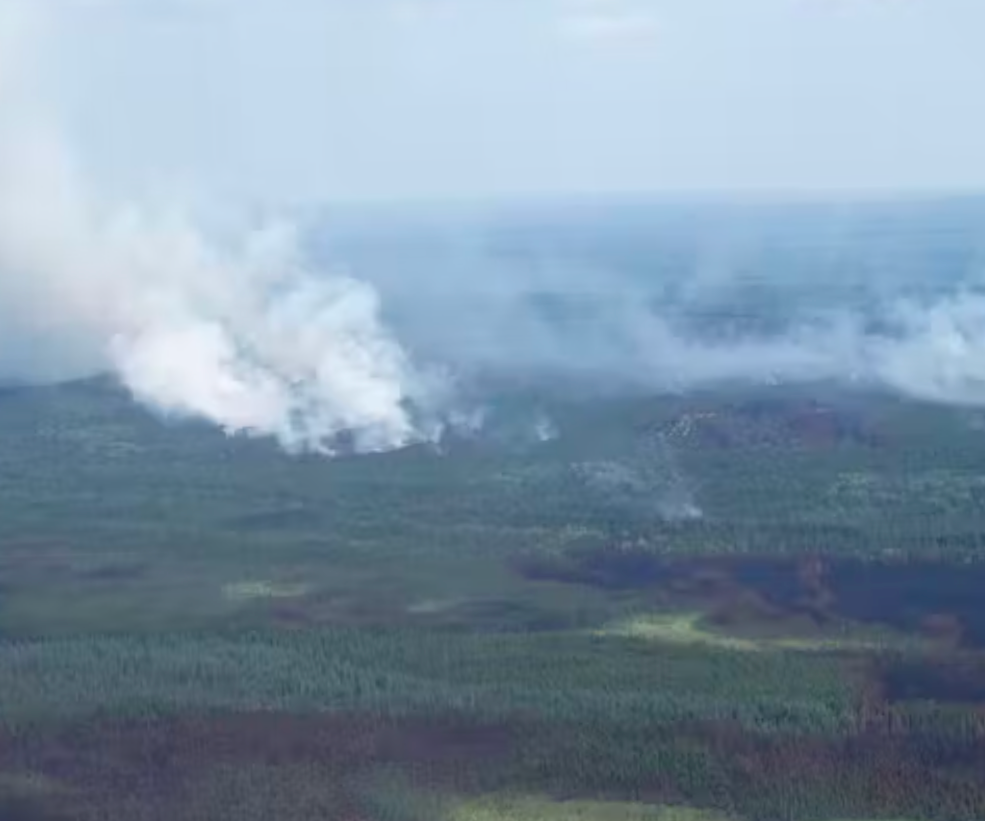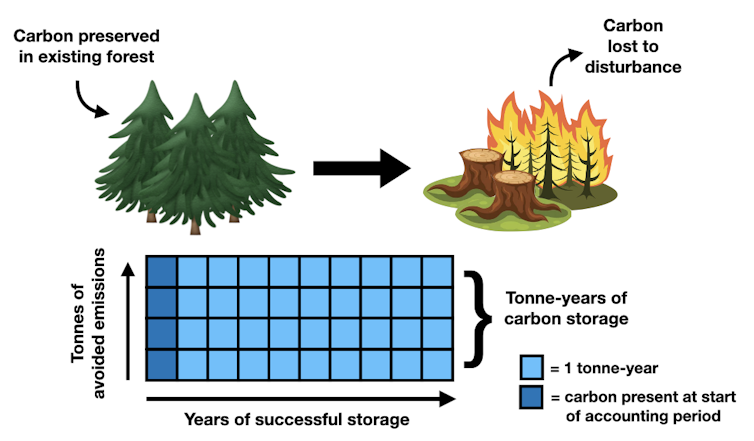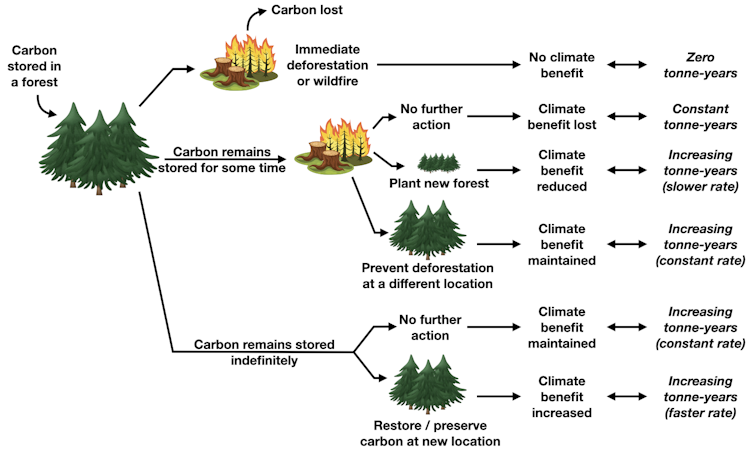Temporary carbon storage in forests has climate value — but we need to get the accounting right
H. Damon Matthews, Concordia University; Alexander Koch, University of Hong Kong; Amy Luers, Concordia University, and Kirsten Zickfeld, Simon Fraser University
Forests and other natural carbon reservoirs play an important role in slowing and potentially reversing the effects of climate change.
But any carbon stored in nature is vulnerable to either natural or human-caused disturbances. This is one reason why offsetting fossil fuel emissions with natural carbon storage is problematic. If the carbon is lost to the atmosphere, then the offset potential is also negated after it has already been claimed and accounted for.
Current accounting mechanisms for natural carbon storage do not adequately deal with the risk of loss due to disturbances. Typically, carbon offsets and removal credits focus only on the amount of carbon stored, and assume that this carbon will remain in storage indefinitely.
But what if we measured and tracked both the amount and time of carbon storage? As we show in our new research published in Nature Communications, this can be done using the tonne-year metric — defined as the amount of carbon storage multiplied by the number of years that it remains stored.
Temporary is not permanent
Tonne-years have so far been used to measure the equivalency of temporary to permanent carbon storage. Previous researchers have argued that as few as 30 tonne-years of temporary storage could be seen as equivalent to one tonne of permanent storage. But from a climate perspective, temporary and permanent storage are very different things and are not interchangeable.
Moreover, offsetting a permanent emission from fossil fuels with tonne-years of temporary storage is not climate neutral. Offsetting with temporary storage will in fact result in more long-term warming when the stored carbon is lost back to the atmosphere.
Tonne-years are a measure of the amount of carbon and the time it remains stored. (H. Damon Matthews, Author Provided)
The same is true of carbon-removal credits that are included in many corporate net zero strategies. Carbon removal that leads to temporary storage will not achieve net-zero emissions if that act is credited as equivalent to an emission that has a permanent climate impact.
But any carbon storage in nature does have climate value, even if it ends up being temporary. Whether preserved in existing reservoirs (for example, via avoided deforestation) or restored in new reservoirs (for example, via reforestation), more carbon stored in land ecosystems means less carbon in the atmosphere and consequently less climate warming. Furthermore, temporary storage has the potential to decrease peak warming, if combined with aggressive fossil fuel emissions abatement.
We need a new way to account for temporary carbon storage in a way that reflects its actual climate value.
Measuring carbon storage time
What if temporary carbon storage was measured and tracked as an independent contribution to climate mitigation, rather than as a fossil fuel emissions offset or removal credit? In this scenario, the tonne-year metric could be used to correctly measure the climate benefit of temporary storage.
Immediate loss of the stored carbon due to wildfire or deforestation would of course negate its value, resulting in no climate benefit.
If the carbon is retained in storage for some period of time (by preventing deforestation at that location, for example), the climate benefit of that forest would be retained during the period of storage. This benefit would then be reversed when the carbon is lost to disturbance. If no further action is taken in this case, the climate effect of the temporary storage would again be negated.
The climate benefit of temporary carbon storage achieved via either avoided deforestation or reforestation can be measured and tracked over time using the rate of increase of tonne-years. (H. Damon Matthews, Author Provided)
However, this loss of carbon could be mitigated by the preservation of an equivalent amount of carbon at a different location, which would then maintain a constant level of climate benefit. Carbon at the disturbed location could also be restored via reforestation, but this would not attain the same climate case, representing sustained climate benefit).
If the amount of carbon storage decreases, this will cause tonne-years to increase by a smaller amount each year (slower rate case, representing decreasing climate benefit). If carbon storage increases, either via forest growth of via expansion of protected forest area, this will generate a larger annual increase in tonne-years (faster rate case, representing increasing climate benefit).
Tracking the benefits
All of these cases can be described by a single quantity: the rate of change of total tonne-years in the system.
If the number of tonne-years does not increase with time, this means there is no carbon storage, and therefore no climate benefit.
If tonne-years increase at a constant rate, this represents a sustained amount of carbon storage and sustained climate benefit. If this rate of increase of tonne-years slows, it indicates that previous climate benefits are being lost or eroded. But if tonne-years increase at an faster rate, this means that total carbon storage and consequent climate benefit is also increasing with time.
In our research paper, we quantify this climate benefit as an amount of avoided temperature change that can either be sustained, increased or eroded over time. We show further that tonne-years of carbon storage are proportional to degree-years of avoided warming, which represent a running total of the avoided warming caused by temporary carbon storage.
Consequently, tonne-years of carbon storage can be equated to a meaningful physical climate quantity that can be monitored based on the rate of change of tonne-years over time.
If reimagined in this way, tonne-year accounting could be used to measure and track the actual climate benefit of natural carbon storage, without requiring a guarantee of permanence. This could help to unlock the potential of nature-based carbon storage as a climate mitigation strategy and not just as an alternative to fossil fuel emissions reductions.

H. Damon Matthews, Professor and Concordia University Research Chair in Climate Science and Sustainability, Concordia University; Alexander Koch, Head of Geospatial at Trove Research, University of Hong Kong; Amy Luers, Affiliate Professor, Geography, Planning and Environment, Concordia University, and Kirsten Zickfeld, Distinguished Professor of Climate Science, Simon Fraser University
This article is republished from The Conversation under a Creative Commons license. Read the original article.
« Voix de la SRC » est une série d’interventions écrites assurées par des membres de la Société royale du Canada. Les articles, rédigés par la nouvelle génération du leadership académique du Canada, apportent un regard opportun sur des sujets d’importance pour les Canadiens. Les opinions présentées sont celles des auteurs et ne reflètent pas nécessairement celles de la Société royale du Canada.




